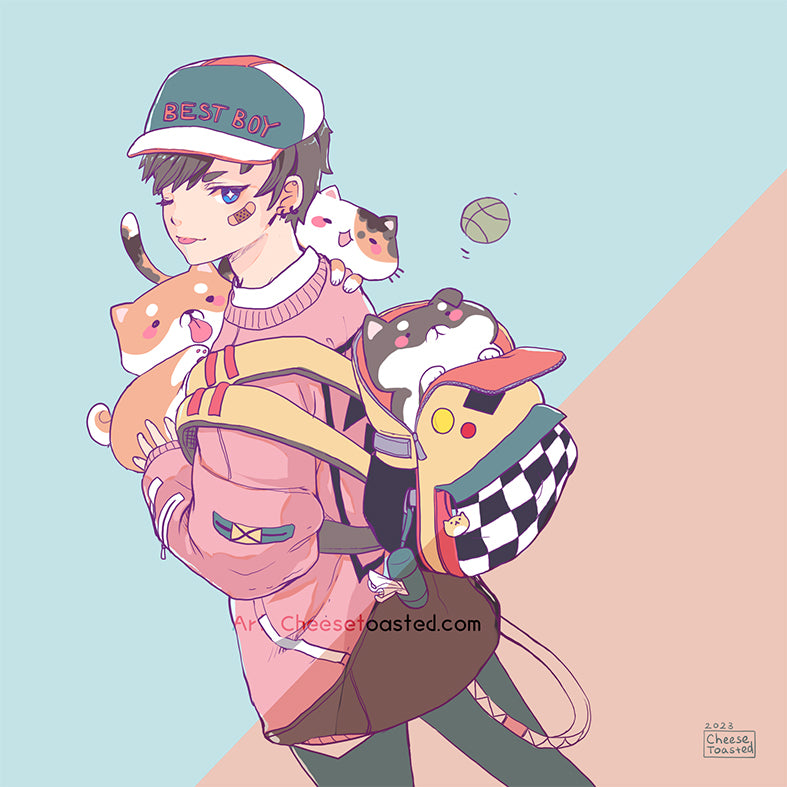The start of my design career: Learning about manufacturing and fabrics
After getting my 4 year design degree in industrial design & visual communications design, I realized I never utilized my learned knowledge to real life. I worked in a marketing agency for a while before I became a freelance artist for the next few years, moving further and further away from my design origin. While I loved doing art, I was getting burned out, I loved drawing, but at the end of the day, I always identified myself as a designer more than a fine artist. Then, a year before I decided to return to school for nursing, I decided to finally put my 4-year worth of design knowledge to test.
For a designer, form & function is heavily wired into my brain, so I began to look at a something that I would love to do (illustrations), but able to fuse it with something that is practical, and not just something people hang on their walls. The world is full of business possibilities, and people are often told to cater to as many groups of audience as possible to build your branding. However, I went the opposite route. I decided to narrow my original target to just my local market, within my city. I’m by no means a smart business person, I just think catering to too many people would probably explode my brain.
I looked at what I WOULD LIKE TO HAVE living in my own City. With Calgary being a place with fluctuating weather patterns, it’s not surprising many of us have two sets of clothes ready for any day of the week, regardless of season. So, I thought to myself, you know, I would love to have some sweaters that I can wear when that wind starts to blow, but not in a tough windproof material, instead, in something that’s soft. Wouldn’t that be nice? I obviously am not aiming for something fancy like 1069% windproof, but a happy middle ground where my hoodie isn’t thin or made of French terry fabric, but still be able to offer some nice warmth when the sun sets, even in some wind? That would be nice. On top of that, I thought it would be great to add some colours onto the streets, but without it being so overpowering that it draws too much unwanted attention. Now that I had a baseline idea, I began looking at the world of designing apparels, specifically, I focused in on sweaters, something that I loved the most. There weren’t too many other fancy reasons on why I decided on that.
After researching and throwing myself into the fashion world, I was immediately overwhelmed, colour palettes, styles, fabrics, types of printing was a lot of small pieces that I needed to put together. I’m also not a fashion designer, nor did I have experience. I had a lot to learn and to catch up on.
Then there was no way I can afford to make apparels, especially if I want to control every aspects of it, from style, design, to fabric and sewing requirements. Before I get to that though, I still needed prototypes. As this post is already looking super long, I’m going to focus on fabric in this specific post, and talk about other parts of designing & costs in future posts.
When I got in contact with a few fabric manufacturer, I pretended I understood everything in fear of getting ghosted, but in reality, I didn’t know anything(lol). Thank god for google and the ability to order samples. With the 4 very original designs from Cheese Toasted, they were all done on 4 different fabrics. There were 2 unreleased sweaters on a fabric that never saw the light of day (which was a good thing, trust me bro). After all the guessing and sampling, though, my best data were all based on guesses and theorizing. What I really needed to do was to release the sweaters in various types of fabric, and let my audience decide what they like the best. I will then revise my formula for future releases, if I survive that long.
So, when the OG sweaters were released, people noticed how every single sweater style felt different. I used the traditional light blue fleece on one of the designs as a control. It wasn’t anything fancy, it had the same hand feel as what you would find in sweaters in big brand stores, but it gave people a sense of familiarity. This fabric was chosen for my very first design, the shiba inu sweater.
Then I picked a super thick fleeced lined jersey, I wanted to see if people would’ve liked that due to Calgary’s fluctuating weather, or would it be too much? Basically, I was going for the extreme end of fleece lined jerseys. I later deemed this fabric as super impractical and it made the sweaters unflattering sometimes, but that’s story for another day. This fabric material was assigned to the fuzzy sheep sweater, I thought it was quite fitting for the material I wanted to experiment on haha.
And then came the two most experimental fabrics, a thinner, soft black fleeced line fabric (gamer black sweater), and a thicker, softer pink fleeced lined fabric (bento pink sweater). My biggest fear with these two were pilling, especially with the thinner black material, but I wouldn’t have any feedback until a few years later, when my buyers came back and gave me some surprising verdict.
If anyone was curious about the 2 unreleased fabrics, they were 100% cotton-type fabrics. Being someone who is sensitive towards non-cotton materials myself, I wanted to make sure I gave my favourite material a try. That experiment ended super quickly, when I learned that I won’t be able to iron out the sweaters due to my stubborn ideology of using silk screen printing (one should not iron over the screen printed graphics). After trialing the cotton sweaters in my washer and dryer, and leaving the sweater crumpled up in the dryer for 3 days, I realized there were no ways to get rid of some of the creases via iron. Unless someone want to spend all their time ironing out the small gaps between my printed
designs, or using a steamer. This was simply not practical by my definition, since I’m a lazy person who does not take care of her own clothing well, and I wanted my own clothing brand to be a tough cookie that require minimal maintenance.
In the end, I settled on the 60% cotton to 40% synthetic formula for the final sweaters. I mean, the fabric would still crease a little if you leave it crunched up too long after a wash, but it definitely didn’t look like a creasing nightmare.
After throwing generation 1 sweaters out into the wild, I went on a hiatus for a few years while I completed my nursing degree, but when I came back, I was blessed with feedback from my sweater buyers! The consensus was everyone loved the softer jersey fabric, and that it surprisingly did not end up pilling (most of the time). Except for that one customer telling me his had some pilling, which disappointed me initially, but then it turns out that was on the light blue classic fabric I originally used as control, and not on the softer fabric formula. People also told me that my silk screen printing remained in pretty good shape, but that’s a story for another time.
Today, all the newer Cheese Toasted fabrics are 65% cotton to 35% synthetic. And our fabric is quite recognizable by long time buyers at this point. I truly owe this final fabric formula to all the feedback from gen 1. Even now, I’m still working on refining the correct thickness I would like. I don’t think I have an all-in-one solution yet, but I’m sure I’ll get there eventually. Today, I still love hearing feedback when I go to conventions, and buyer feedback remains more valuable than any guessing and theorizing. Thank you to all the returning customers who have been giving me feedback for the past few years. I’ll continue to try my best at finding the best fabric possible.
P.S. Oh! And then there are t-shirt fabrics, which remains a much harder monstrosity for me to tackle. I know I’ve had multiple requests to make more t-shirts, but my general response had been “I’ll see” or “T-shirts are a bit more difficult for me”. Basically, T-shirts are pretty much at square one for me right now. It’s easy to make a graphical design and have it printed on any generic shirt, but knowing me, I simply cannot design anything until I find that perfect fabric formula, one that is worthy of being part of this small creative brand. One of my goals is to re-enter into the world of short sleeves in 2025, but that is yet to be seen, and I just need to get over the fear of unknown at starting from square 1 again.
Signing off
The Designer


Leave a comment
This site is protected by hCaptcha and the hCaptcha Privacy Policy and Terms of Service apply.